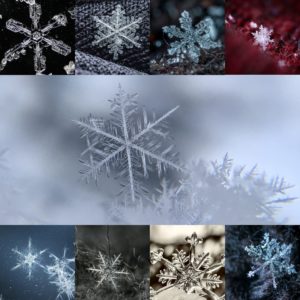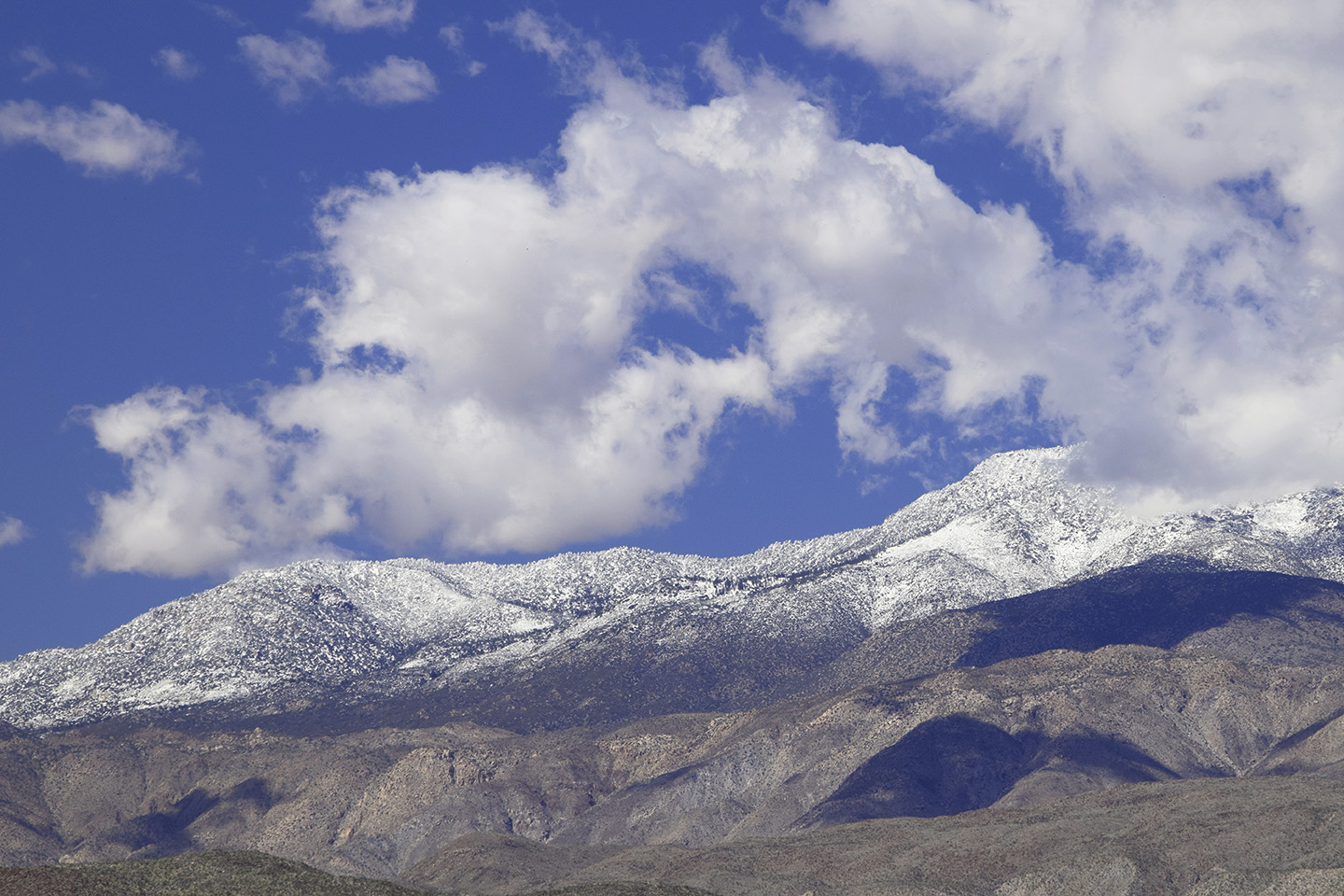Snowflakes & Birthcharts
Master’s Musings, December 2022
Apologies to our Australian compatriots, but for most of us in the FCEA community, winter weather is now upon us, and that means snow. Even here in the western Sonoran desert where Michelle and I live, we’ll soon be seeing it covering the mountains. Here’s a picture to prove it:
I’ll admit to gloating a bit – I was standing just outside my front door when I snapped this shot, but I was probably just wearing a tee-shirt. The top of the mountain you see is about 8000’ higher than our house. It’s a lot colder up there! We never see snow on the ground here at home.
Personally, I’m fine not dealing with ice and snow – but even with my more tropical disposition, every year we do love driving up to the high ground and soaking up the winter wonderland.

The reason I am saying all of this is that snow actually has a powerful lesson for us as astrologers. It’s often said that every snowflake is different and unique. Yet they’re all built out of exactly the same stuff – water. On top of it, all of them have roughly the same beautiful form: a six-armed mandala. From an astrological perspective, snowflakes are just like us, in other words. Like them, we are all different and yet we are all alike.
Every human being is built out of the same handful of signs, planets, houses, and aspects – and yet our variations are effectively infinite. Depending on how you count them, astrology is based on a vocabulary of maybe forty “words” – Taurus, the 3rd house, sextiles, and so on – and yet their possible combinations keep ramifying in a fractal way, producing the Vladimir Putins of this world, along with the Christine McVies, the Greta Thunbergs, the Oprahs and the Ram Dasses.
Snowflakes and us – the parallels continue, and here’s where everything gets truly miraculous. Every snowflake that has ever fallen has a certain geometrical feature in common. As I mentioned a few lines ago, all of them have six arms, like an asterisk. It’s the very symbol we astrologers use for the sextile aspect – and if you pie-slice a chart into a series of sextiles, you’ve got the map of a snowflake.

Think carefully about this basic hexagonal snowflake plan. You can say it has six arms – but here’s another way of saying it: you wouldn’t know an arm was there unless there were empty spaces on either side of it. Otherwise it would just be solid. So we could say that actually the basic design of a snowflake involves twelve iterations rather than six – a positive space, followed by a negative space, followed by another positive space, and so on around the circle, just like Yin and Yang in the Taoist model.
Meanwhile in astrology, without forcing anything, we can easily relate the Earth and Water signs to Yin and the Fire and Air signs to Yang – and of course in the zodiac, they alternate too. That means that, just like a snowflake, every chart that has ever existed or could ever exist is based on that same twelve-fold pattern of alternating Yin and Yang energies.
Next time it’s snowing, have a look out your window. It’s snowing zillions and zillions of little birthcharts. If you could study each of them through an ice-cold microscope, you would always see that same fundamental structure. But of course you would also see something else – that each one was beautiful in its own unique way. That’s the part that puts tears of joy and wonder in our eyes – and the part that, in remembering it, we become better astrologers.
Earth’s population just reached eight billion. That’s scary in a lot of ways, but it’s also kind of awe-inspiring to know that underlying each one of those people’s individual psyches, there is a little snowflake-like structure. It’s one that has never existed before in that exact form. It’s called their birthchart.
 Want to know why snowflakes all have six arms? I’m not going to dive into the science of it here – that’s not what this newsletter is about. The science is actually easy to understand though – if you want to understand it, just Google “why do snowflakes have six arms?” It’s all based on water being composed of three atoms – two hydrogens and one oxygen – and how those molecules form chains when they reach the freezing point.
Want to know why snowflakes all have six arms? I’m not going to dive into the science of it here – that’s not what this newsletter is about. The science is actually easy to understand though – if you want to understand it, just Google “why do snowflakes have six arms?” It’s all based on water being composed of three atoms – two hydrogens and one oxygen – and how those molecules form chains when they reach the freezing point.
Here, though, I’m trying to think more like an astrologer and less like a scientist. That always leads us back to the most fundamental statement of astrological theory – four words that go back to Hermes Trismegistus in long-ago Egypt: as above, so below. In practical astrology, the obvious manifestation of that principle is the way the heavens above are mirrored in the human psyche here below. But the principle is really far broader – it’s about how certain fundamental structures keep echoing each other on different scales in the universe.
Snowflakes and astrological charts are one illustration of that idea. Here’s another: stand up, spread your feet apart and hold your arms up and out at an angle. Two legs, two arms, your head, and your genitals – you’re a little snowflake too. Or a little birthchart.
Let me point you down the science-road again if you feel like traveling it – read about carbon atoms and diamonds, and you’ll soon encounter more esoteric expressions of the same principles. (And from a scientific point of view, what could be more human than a mixture of carbon, hydrogen, and oxygen?) Then there’s the color wheel and the musical scale – all reflect the same unifying, underlying principles. You can read about all of it in my book The Night Speaks if you’re interested.
Back to snowflakes and birthcharts. The deeper point is that the principles of astrology are profoundly woven into the fabric of nature. Unlike so many psychological theories, everything we practice and believe is organic, integral to the actual structure of the cosmos, and present before our eyes.
Most importantly, each snowflake – and each birthchart – teaches us one profoundly spiritual lesson, and that is that, while each one of us is unique, we are all made out of exactly the same stuff. We are all different and we are all the same.
One world, one people – if you can feel it, then this book is dedicated to you – that was the dedication that opened The Inner Sky, and that’s basically the message of all those snowflakes that are falling around you this winter.
Happy holidays!
Steven Forrest
December 2022


